Arts & Culture

Mary Oliver often explored big existential questions with the unlikeliest of philosophical partners: moss, roses, geese, dogs, waves. They all had interesting things to say to her. In a 2015 interview with Krista Tippett, Oliver explained that there is nothing more interesting to her than spirituality. “So I cling to it,” she said. “I have no answers, but have some suggestions.” Her poems are riddled with those suggestions. Here are some of my favorites

The stories we tell ourselves matter, even if you’re an immortal elf. The first season of Rings of Power, Amazon Studios’ new 8-episode prequel to The Lord of the Rings, opens with the scene of a young Galadriel, the Elvish royalty who will refuse Frodo’s offer to wield the One Ring thousands of years in the future.

As it turns out, the person who needed The Rehearsal most was Fielder himself. His interaction with Angela in the finale reveals that the whole enterprise is actually an exploration of the inevitable pain humans cause others, even when we’re not trying to, and our need for grace and self-forgiveness.
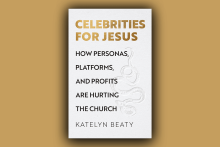
The outrages of celebrity culture have a material basis, with flashy sneakers and luxurious living, but Beaty’s analysis expands to include a deeper psychological and spiritual perspective on the problem.

Viewers would be wise to approach The Sandman expecting a slow burn rather than a breakneck action extravaganza. There’s plenty of horror, but these moments are spaced out through the deeply human moments of Morpheus coming to terms with what it means to serve humanity.
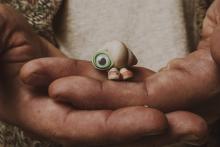
I went to the theater alone, feeling small and bereft. At the urging of a friend, I went to see Marcel the Shell With Shoes On. I felt my smallness increase as the theater darkened. Then suddenly, there was Marcel, a one-inch-tall shell, blinking back at me. Marcel is soft-spoken, inquisitive, and wears pink shoes.

The June release of a Climate Vigil The Porter’s Gate Worship Project aims to nudge Christians toward climate action, but it isn’t alone among contenders to inspire the climate movement. For over 20 years, Carolyn Winfrey Gillette, a Presbyterian minister from New York, has written hymns for the times, including one for the 2021 UN climate talks held in Scotland and several to recognize increasing natural disasters such as wildfires, hurricanes, and floods. Fossil Free PCUSA, a campaign within the Presbyterian Church (USA) has used hymns in protests, including songs by Christian artist Matthew Black.
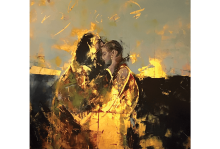
All I wanted was work,
not the old man’s joyful tears as he ran down the hill.
I was afraid he’d fall or burst his heart to kingdom come.
Now what?
My head still pounds from yesterday’s wine, father’s ring hangs heavy on my finger,
and after all those years of pea pods, my stomach aches from too much fatted calf.
I didn’t want that damn banquet,
my older brother pacing outside the door, muttering into his beard.
But he’s right: he deserves a party more than I do.
And next?
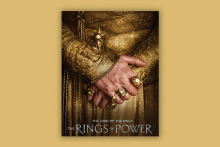
THE RINGS ARE BACK. In September, Amazon Prime Video premieres The Lord of the Rings: The Rings of Power, the newest adaptation of J.R.R. Tolkien’s Middle-earth legendarium. From The Hobbit toThe Lord of the Rings trilogy to The Silmarillion, Tolkien is one of the most beloved fantasy authors of all time. His fictional world has captivated generations of readers and inspired countless spin-offs.
The newest series takes place during the Second Age, long before The Hobbit or The Lord of the Rings. It includes some characters portrayed onscreen before and many more not. While a compressed timeline means story changes are expected, fans hope the show retains the essence of Tolkien’s truths rooted in his Roman Catholic worldview. In his essay “On Fairy-Stories,” Tolkien refers to the act of creating fictional stories as “sub-creation.” He writes that humans take pieces of God’s creation and use them to sub-create “because we are made ... in the image and likeness of a Maker.” Because sub-creation is an expression of God’s creativity, Tolkien also believed that fictional stories reflect truth.
Tom Emanuel, a United Church of Christ minister and Tolkien scholar, compares the resilience of Tolkien’s work to that of the Bible. “Why has the Bible continued to resonate for all these centuries? Because it offers us a glimpse of a Truth beyond everyday failures and disappointments, possibility beyond the worst we can do to one another,” Emanuel told Sojourners. Tolkien’s writings reflect the truth of a world in need of healing yet never without hope, a vision that resonates for Christians pursuing social justice.
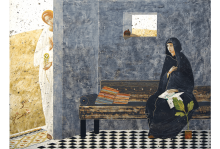
AT THE START of the war in Ukraine, images overwhelmed me. Families crowding onto trains. Teachers holding assault weapons. Nigerian students being held at the border. The clash of human tenderness with extraordinary aggression was arresting. In between checking updates from a friend—an art curator sheltering in Kyiv—Instagram suggested I follow Lviv-based contemporary icon artist Ivanka Demchuk. With fears of global annihilation humming in my head, Demchuk’s fresh, calming pieces, such as “Annunciation” and “Sophia the Wisdom of God,” captivated my attention and softened the edges of my growing despair.
In recent years, Lviv has become a hub of Christian sacred art technique and production. Lviv National Academy of Arts, from which Demchuk graduated, teaches icon creation, sacred space decoration, and icon theology. For centuries, icons helped make Christianity accessible to illiterate populations. But today, it strikes me that we need this life-giving artform in new ways. We are inundated with photographs of violence, from destruction in Ukraine to police brutality in our neighborhoods. Jesus Christ, our Wounded Healer, taught his disciples how to see injustice and move toward it. How can we, as Christian people committed to justice, cultivate these twinned capacities—seeing clearly and seeking social healing—within ourselves?
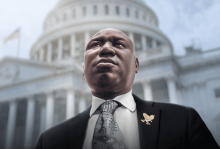
Legal Action
The documentary Civil: Ben Crump follows the civil rights attorney as he represents the families of George Floyd, Breonna Taylor, and Andre Hill. While Crump’s work sheds light on police brutality, he also takes legal action to protect Black farmers and bank customers. Netflix
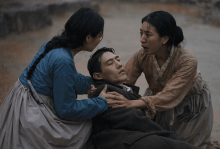
IT'S CLICHÉ AT this point to call television dramas with rich storytelling and emotional depth (think The Wire and Breaking Bad) novelistic. But no show may be more novelistic than Pachinko on Apple TV+. Like the book by Min Jin Lee on which it is based, Pachinko encompasses four generations of a Korean family, following them from Korea to Japan throughout much of the 20th century. But while the book moves linearly, the TV show shifts back and forth from 1989 to the 1920s onward, with one actor (Minha Kim) playing the protagonist Sunja when she is a young woman and another (Oscar-winner Yuh-Jung Youn from Minari) when she is a grandmother.
Hollywood often seems to assume that viewers need stories that match our limited comprehension. But lately there’s been a shift, with Korean artistry initiating the move. Hollywood, uncharacteristically, embraced the South Korean thriller Parasite, the first non-English-language film to win Best Picture at the Oscars, and went equally wild for the South Korean TV drama Squid Game, the first non-English-language show nominated for Screen Actors Guild Awards (winning three). Subtitles—kisses of obscurity in Hollywood—become something sweeter: Trust? If so, Pachinko puts double the faith in non-Korean- and non-Japanese-speaking viewers, subtitling the Korean in yellow and the Japanese in blue and juxtaposing the colors when both languages flow from a character's mouth in a single line of dialogue. At times, the bottom of the screen resembles Vincent van Gogh’s “The Starry Night.”

IN THE DARKNESS, I heard a voice calling my name: “Hi, Olivia.” I couldn’t control my arms and legs enough to acknowledge the voice. Again: “Hi, Olivia.” At this point I was feeling sheepish. Finally, the voice said to me, “Olivia, I think you’re muted. If you want, you can turn your mic on.”
The voice was that of Steven Roberts, who serves as Life.Church’s online host team pastor. I was attending my first church service in the metaverse.
The darkness faded, and I saw the words “Life.Church” written on the face of a computer-simulated grey, black, and white building. I (or rather my avatar) walked through the building doors into a lobby with welcome signs and informational graphics about the mission and history of Life.Church. There was even a game room with a playable pool table and dartboard. I directed my avatar to the sanctuary.
Life.Church is a multicampus church in the Evangelical Covenant Church denomination. Led by Craig Groeschel and based in Edmond, Okla., it has 44 physical locations in the U.S. and has now ventured into the metaverse.
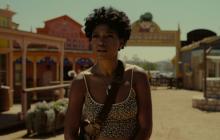
Nope, writer/director Jordan Peele’s third theatrical release, opens with a Bible verse: “I will pelt you with filth, I will treat you with contempt and make you a spectacle” (Nahum 3:6). Cut to a blood-soaked sitcom set where a chimpanzee — arms and mouth also covered in blood — wanders around before settling down and looking at the audience.

Core to Christianity is this notion of hospitality and trying hard to hear your neighbor, hear what they’re trying to say, and even giving voice to what they’re trying to say. And you may not always agree with the melody. But part of what we see Jesus do is pay attention to the fact that every person in front of him has a melody that God’s given them.

What makes a god worthy of worship? A heavy question, and probably not one you’d expect from the Marvel Cinematic Universe. But writer, director Taika Waititi’s latest film, Thor: Love and Thunder, takes aim at that very question.

Scripture is quoted twice in the latest season of Stranger Things, a first for the Netflix original that introduced us to the military experiments happening in the small Midwestern town of Hawkins, Eggo-loving Eleven, and the magic of Steve Harrington’s hair.

I was in elementary school when the first Harry Potter books were published in the United States. At the time, I was a painfully shy and awkward child; I treasured my library card and found solace in the stacks of books I carried home from our local branch. Though I was a prime target for a sensational new children’s book series, my parents — like the rest of our fundamentalist Baptist church — deemed anything about witchcraft inappropriate reading for good Christian children.

Above all else, Luhrmann displays Elvis as a man-turned-god who was exhausted trying to make peace with his paradoxes.
